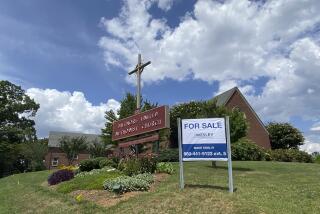The Bigger the Better, Church Consultant Says : Change: ‘Mega-churches,’ or large multifaceted congregations, are better prepared to deal with the needs of people today, an expert contends.
Small “mom-and-pop” grocery stores have the charm of first-name familiarity, and you can get credit if needed. But despite the personal touches, most people patronize supermarkets.
The contrast, says church planner Lyle E. Schaller, is a key pointer to the effectiveness of today’s Christian congregations and a hallmark of their future.
“The emergence of the ‘mega-church’ is the most important development of modern Christian history,” he said.
“In today’s world, big churches are more attractive to younger adults. People nowadays want a church that offers a broad range of choices in teaching, scheduling and programming.”
Schaller, a widely respected expert on strategies for strengthening churches and adjusting to the needs of a changing world, said evidence is mounting that large, multifaceted congregations now work best.
“The record is pretty clear that small churches are not attracting people as they did before,” he said.
“You can be sentimental about the small congregation, like the small corner grocery store or small drugstore, but they simply can’t meet the expectations that people carry with them today.”
Schaller, 67, a United Methodist clergyman and consultant, is a former city planner who became a specialist in church planning. He has been charting effective church strategies for more than 30 years and advises parishes of various denominations and church conferences across the country.
“Adults born in the ‘50s and ‘60s don’t carry the institutional loyalty of older generations,” he said. “People today expect to make choices about things--about a new TV, an automobile, what they eat, their housing.”
He said the same approach applies increasingly in choosing a church, which is done mainly on the basis of large, varied, well-run programs, with little regard for denomination.
“It’s part of the consumer orientation,” he said. “Parents and grandparents stayed with their denomination, but people from age 40 down to 25 don’t have that denominational loyalty. They shop around.
“Whether it’s right or not is not terribly important. It’s where we are. The churches have to live where the world is.”
He said a reason for membership declines in the old, mainline Protestant bodies has been their fostering of small and moderate-size congregations instead of the increasingly popular big, versatile churches.
The proportion of large congregations in mainline denominations such as United Methodist, Presbyterian, United Church and Christian Church (Disciples of Christ) has declined, along with membership, he said.
He said huge congregations with manifold ministries, educational classes and other programs, both weekends and through the week, have multiplied in growing evangelical and nondenominational sectors.
“Denominations don’t count much anymore,” he said. “We see that clearly in the new congregations that don’t carry any denominational affiliations.”
He said the big, super-programmed “mega-churches” have developed all across the theological spectrum, a few of them liberal, many of them conservative, and “a bunch of them middle-road” and nondenominational.
Schaller, who lives in Naperville, Ill., said vigorous educational programs and able preaching are marks of successful congregations and characteristic of the big ones.
The teaching is “not just in Sunday school, but all during the week,” with more people in classes on weekday evenings than on Sunday morning.
He agreed with recent conclusions of an extensive, prolonged study in six mainline Protestant denominations by the Search Institute of Minneapolis that found their educational efforts badly lacking.
“Teaching just hasn’t been pushed as hard as it should be,” he said. “But most big congregations are doing an excellent job.”
More to Read
Sign up for Essential California
The most important California stories and recommendations in your inbox every morning.
You may occasionally receive promotional content from the Los Angeles Times.









